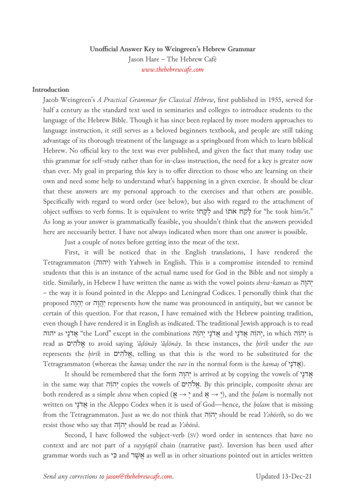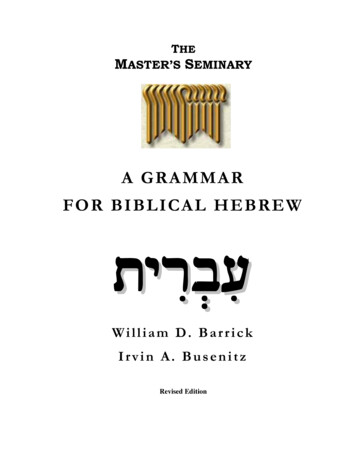
Transcription
THEMASTER’S SEMINARYA GRAMMARFOR BIBLICA L HEBREWtyrIb.[iWilliam D. BarrickIrvin A. BusenitzRevised Edition
2Barrick & Busenitz, A Grammar for Biblical Hebrew 2011 Grace Books InternationalSun Valley, CABWHEBB, BWHEBL, BWTRANSH [Hebrew]; BWGRKL, BWGRKN,and BWGRKI [Greek] Postscript Type 1 and TrueTypeT fonts Copyright 1994–2009 BibleWorks, LLC. All rights reserved. These Biblical Greekand Hebrew fonts are used with permission and are from BibleWorks,software for Biblical exegesis and research.
Barrick & Busenitz, A Grammar for Biblical Hebrew3PREFACEOriginally, the authors had composed their own individual grammars during the course ofteaching Biblical Hebrew on the seminary level for many years. It was a pleasant surprise tofind that each had adhered to the same basic philosophy of teaching Hebrew grammar. Therewere some areas that had been developed differently, but the general design was harmonious.A Grammar for Biblical Hebrew represents a combining of those two grammars. It is ourhope and prayer that the use of this grammar will prove to be a joyful exercise resulting in anunderstanding of the Hebrew Old Testament. For this revised edition the authors present atotally new and updated vocabulary for the lessons and for the appendixes.Special thanks is offered to Dr. Michael Grisanti, who has read and commented on thisgrammar as it has been (and is being) developed, and to Scott Bashoor, Brian Rickett, andBryan Murphy who have taught the course with this textbook for a number of years. Thanksare also due to all those students who have patiently endured (and who are enduring) theprocess of developing and testing this volume in the classroom. Doubtless, our students haveexperienced the scriptural warning, “. . . beyond this, my son, be warned: the writing of manybooks is endless” (Eccl 12:12a, NASB). Be assured that the authors have experienced the factthat “excessive devotion to books is wearying to the body” (12:12b). As exhausting as theprocess might prove to be, however, we are not to be “weary of doing good” (2 Thess 3:13).
4Barrick & Busenitz, A Grammar for Biblical Hebrew
Barrick & Busenitz, A Grammar for Biblical Hebrew5Table of ContentsTable of Abbreviations & Symbols Introduction The Identity and History of the Hebrew Language .Chapter 1The Alphabet — Consonants .Chapter 2The Alphabet — Vowels .Chapter 3The Alphabet — Special Letters, Dagesh, and Raphe .Chapter 4The Alphabet — Half Vowels .Syllables Chapter 5Accents;; Review of Syllables Chapter 6The Article and Interrogation Chapter 7Prepositions .Chapter 8Conjunctions and the Relative Pronoun Chapter 9Noun and Adjective: Their Gender & Number .Chapter 10Noun and Adjective: Their Relationship .Demonstrative Pronouns Chapter 11The Construct State Chapter 12Personal Pronouns, the Particle tae, and Accusatives . The Definite Object . . . . . . . . . . .The Old Accusative Chapter 13The Regular Verb — Perfect .Chapter 14Pronominal Suffixes for Nouns .Chapter 15Pronominal Suffixes for Prepositions and tae .Chapter 16The Regular Verb — Imperfect and Imperative .Chapter 17The Participle .Chapter 18The Infinitive .Cardinal and Ordinal Numbers . .Parsing Sheets .Chapter 19Segholate Nouns and Stative Verbs Chapter 20The Waw-Consecutive and Waw-Correlative .The Niphal Conjugation .Chapter 21The Piel and Pual Conjugations .Chapter 22The Hiphil and Hophal Conjugations .Chapter 23The Hithpael Conjugation .Chapter 24Pronominal Suffixes for the Perfect/Qatal .Chapter 25Pronominal Suffixes for the Imperfect/Yiqtol Chapter 26Weak Verb Forms — 1st Root Letter .Chapter 27Weak Verb Forms — 2nd Root Letter Chapter 28Weak Verb Forms — 3rd Root Letter Recognition of Hebrew Roots .Chapter 29The Uses of the Hebrew Conjugations Appendix 1 19125127134137141144149155159163167173181187192195
6Barrick & Busenitz, A Grammar for Biblical HebrewAppendix 2: Hebrew Charts
Barrick & Busenitz, A Grammar for Biblical HebrewTable of Abbreviations & Symbols§§§123absaccactadjadvartBDBsection (usually a reference to a section in a reference grammar)sections1st person (with reference to verbs)2nd person (with reference to verbs)3rd person (with reference to verbs)absolute; cf. infaccusative caseactiveadjective, adjectivaladverb, adverbialarticleFrancis Brown, S. R. Driver, and Charles A. Briggs, eds., A Hebrew and EnglishLexicon of the Old Testament, corrected ed. (Oxford: Clarendon Press, 1952)BHSK. Elliger and W. Rudolph, eds., Biblia Hebraica Stuttgartensia (Stuttgart:Deutsche Bibelstiftung, 1967–77).ccommonChisholm Robert B. Chisholm, Jr., From Exegesis to Exposition: A Practical Guide toUsing Biblical Hebrew (Grand Rapids: Baker Books, 1998)cohcohortativeconconstruct (used for both the construct state of the noun and, with inf, for theinfinitive construct); cf. gen, infconjconjunctionconsconsecutive (waw-cons waw-consecutive)corrcorrelative (waw-corr n, editorffeminine (sometimes: ve case; also, conGKCE. Kautzsch, ed., Gesenius’ Hebrew Grammar, 2nd English ed., trans. and ed. byA. E. Cowley (1910; reprint, Oxford: Clarendon Press, 1966)HALOT Ludwig Koehler and Walter Baumgartner, eds., The Hebrew and AramaicLexicon of the Old Testament, 5 vols., rev. by Walter Baumgartner and JohannJakob Stamm, trans. and ed. by M. E. J. Richardson (Leiden: E. J. Brill, 1994–2000)HBIFrederic Clarke Putnam, Hebrew Bible Insert (Quakertown, PA: StylusPublishing, 1996)Holladay William L. Holladay, A Concise Hebrew and Aramaic Lexicon of the OldTestament (Grand Rapids: Eerdmans, 1971)7
8Barrick & Busenitz, A Grammar for Biblical HebrewBruce K. Waltke and M. O’Connor, An Introduction to Biblical Hebrew Syntax(Winona Lake, IN: Eisenbrauns, 1990)impfimperfect (with reference to the yiqtol verb form)impvimperativeindefindefiniteinfinfinitive: inf abs infinitive absolute, inf con infinitive constructintranintransitiveJ-MPaul Joüon, A Grammar of Biblical Hebrew, 2 vols., trans. and rev. by T.Muraoka, Subsidia Biblica 14/I–II (Rome: Pontifical Biblical Institute, 1996)jussjussiveLXXSeptuagintmmasculine (sometimes: masc.)midmiddlemsmanuscript; mss manuscriptsMTMasoretic TextNIDOTTEWillem A. VanGemeren, ed., New International Dictionary of Old TestamentTheology & Exegesis, 5 vols. (Grand Rapids: Zondervan Publishing, 1997)nomnominative caseNTNew TestamentOTOld Testamentpplural (sometimes: pl.)partparticlepasspassiveperfperfect (with reference to the qatal verb form)ppronpersonal pronounpretpreteritepronpronoun, pronominalptcpparticiple, lative (rel pron relative pronoun)ssingular (sometimes: sg.)SPSamaritan PentateuchstatstativeSyrSyriac PeshittaTDOTG. Johannes Botterweck, Helmer Ringgren, and Heinz-Josef Fabry, eds.,Theological Dictionary of the Old Testament (Grand Rapids: EerdmansPublishing, 1974–2008)TgTargum(s)TLOTErnst Jenni and Claus Westermann, eds., Theological Lexicon of the OldTestament, 3 vols., trans. by Mark E. Biddle (Peabody, MA: HendricksonPublishers, 1997)transtransitiveTWOTR. Laird Harris, Gleason L. Archer, Jr., and Bruce K. Waltke, eds., TheologicalWordbook of the Old Testament, 2 vols. (Chicago: Moody Press, 1980)IBHS
Barrick & Busenitz, A Grammar for Biblical Hebrewvverse; vv versesVLatin VulgateWilliams Ronald J. Williams, Hebrew Syntax: An Outline, 2nd ed. (Toronto: University ofToronto Press, 1976, reprinted 1992)9
10Barrick & Busenitz, A Grammar for Biblical Hebrew
Barrick & Busenitz, A Grammar for Biblical Hebrew11IntroductionIn the Word – Exegetical InsightsThe driving force of this Grammar is to introduce the student to the Hebrew text of theHebrew Scriptures as soon as possible. Its goal is the exegesis of the Hebrew text preparatoryto expounding the OT Scriptures. To that end, commencing with Chapter 6 each chapter ofthis textbook starts with a section entitled In the Word – Exegetical Insights. The versesmay be used devotionally by the instructor or by the student studying on his own. Additionalmaterial about each verse is located in an appendix in the back of the textbook. It is alsosuggested that the student spend time repeatedly reading aloud the Hebrew of these verses forthe purpose of gaining fluency in pronunciation and classroom reading. The authors haveemployed some transliteration in the early chapters to help the student gain proficiency inproper pronunciation. From Chapter 6 onward, however, the student should read only theHebrew, not the transliteration of Hebrew.The following symbols are employed in In the Word – Exegetical Insights: Paragraphs marked with this symbol guide the student to helpful sections withinthe Grammar. Grammatical and syntactical notes are indicated by this symbol.Goals for the Study of Biblical Hebrew To gain a working knowledge of Biblical Hebrew grammar.To gain a working understanding of Biblical Hebrew grammatical thoughtprocesses. It is not possible for the modern teacher or student to completelyunderstand how the original writers thought when they wrote, but it is desirable toget as close to that understanding as possible.To gain an increased interest in and appreciation for the OT and the languages inwhich it was written.To experience how Hebrew, with the preceding goals, can assist in spiritualmaturation and ministry.To be able to read aloud the Hebrew of any passage of the Hebrew OT.To be able to translate simple sentences from the Hebrew OT.Importance of the Study of Biblical HebrewThe OT was written in two languages: Hebrew and Aramaic. Hebrew is the primarylanguage in which the greater part of the OT was written. The portions which were written inAramaic include a place name in Genesis 31:47, one verse in Jeremiah (10:11), and sectionsof Daniel (2:4–7:28) and Ezra (4:8–6:18; 7:12–26).
12Barrick & Busenitz, A Grammar for Biblical HebrewHebrew is the language God employed to communicate His message to His people. Forthe student of Scripture, knowledge of Hebrew is an invaluable asset for properlyunderstanding the OT.In addition to a proper understanding of the OT, a knowledge of Hebrew aids inunderstanding the NT. Much of the NT is based upon the OT. OT quotations and allusions inthe NT need to be understood in their original context before the interpreter can understandtheir use by the NT writers.Knowledge of biblical Hebrew is a guard against theological error. The final authority forfaith and practice is the written Word of God. However, the believer needs to interpret thatWord in order to apply it. In that interpretative process the final court of appeal in disputesover interpretation resides in the original languages of the Scripture.According to the Polish rabbi, Haim Nacham Bialik, “Reading the Bible in translation islike kissing your bride through a veil.” The student of Scripture should attempt to draw asnear to the original sources as possible, so as not to be dependent upon others for what thetext says or means. In other words, “For the minister, a knowledge of Hebrew is necessarybecause it opens up the only truly reliable interpretive window upon the text of the OldTestament.”1The student should prayerfully consider the following words of the great reformer,Martin Luther:Though the faith and the Gospel may be proclaimed by simple preacherswithout the languages, such preaching is flat and tame, men grow at lastwearied and disgusted and it falls to the ground. But when the preacher isversed in the languages, his discourse has freshness and force, the whole ofScripture is treated, and faith finds itself constantly renewed by a continualvariety of words and works.It is a sin and shame not to know our own book or to understand the speechand words of our God; it is a still greater sin and loss that we do not studylanguages, especially in these days when God is offering and giving us menand books and every facility and inducement to this study, and desires hisBible to be an open book.21Stephen J. Andrews, “Some Knowledge of Hebrew Possible to All: Old Testament Exposition andthe Hebraica Veritas,” Faith & Mission 13, no. 1 (1995): 98. The beginning student is strongly encouraged tolocate the article by Andrews and to read it before completing the first month of study in Biblical Hebrew.Another article that will prove equally enlightening and rewarding is Walter C. Kaiser, Jr., “The Future Role ofthe Bible in Seminary Education,” Concordia Theological Quarterly 60, no. 4 (Oct 1996): 245–58 (especially,252–54).2John Piper, The Legacy of Sovereign Joy: God’s Triumphant Grace in the Lives of Augustine, Luther,and Calvin (Wheaton, IL: Crossway Books, 2000), 99–100.
Barrick & Busenitz, A Grammar for Biblical Hebrew13The Identity and History of the Hebrew Language1A.A Semitic Language. Hebrew is a member of the Semitic3 family ofapproximately 70 languages.4 The Semitic languages are found in ageographical zone including Palestine, Mesopotamia, the Arabian peninsula,and Ethiopia. Hebrew belongs to the Northwest branch of Semitic languages.Although there is some debate concerning the characteristics common to themembers of the Semitic family of languages, most Semitics scholars generallyidentify the following with the Northwest Semitic branch: 2A.The Table of Semitic Languages. The Northwest branch of the Semiticlanguages is but one of three main branches (Northwest, Southwest, andEastern). The following identifies the major Semitic languages:1B.3A 3–letter (triliteral) morphological root system dominates wordformation.5An initial waw ( w) changes to yod ( y) as the first root letter,especially in the formation of verbs.An unvocalized nun ( n) is completely assimilated to the followingconsonant.There is evidence for three basic case endings:6 a u-class vowel as thenominative ending, an i-class vowel as the genitive ending, and an aclass vowel for the accusative ending.The feminine ending –at on noun forms drops the t in the absolute statebut maintains it in the construct state.Hebrew Hebrew is closely related to Phoenician and Ugaritic. The people of Israel spoke Hebrew until the Babylonian Exilewhen it began to be replaced by Aramaic (cf. Nehemiah 8 and13). By the end of the first century A.D., Aramaic rather thanHebrew was the commonly spoken language of Israel. Hebrewwas originally written in the old Phoenician script. One result ofthe Babylonian Captivity and the transition to Aramaic was thatSemitic is derived from the name of Shem, the son of Noah, because of identifiable similaritiesbetween the languages spoken by certain genealogical branches of his descendants (cf. Gen 10:21–31).4Angel Sáenz-Badillos, A History of the Hebrew Language, trans. by John Elwolde (Cambridge, UK:University Press, 1996), 3.5The morphological roots of Northwest Semitic are not exclusively triliteral. There are a number of 2letter (biliteral) roots as well. Bergsträsser considered triliterality a “prevailing trait of Semitic” — GotthelfBergsträsser, Introduction to the Semitic Languages, trans. by Peter T. Daniels (Winona Lake, IN: Eisenbrauns,1983), 6.6Case endings indicate the grammatical function of nouns in a clause. In biblical Hebrew these threecase endings are often merely the remnants of an earlier pattern that had already undergone change. Cf.Bergsträsser, Introduction to the Semitic Languages, 17, 60; and, Sáenz-Badillos, A History of the HebrewLanguage, 23.
14Barrick & Busenitz, A Grammar for Biblical Hebrew writers of Hebrew borrowed the Aramaic square script withwhich to write Hebrew. Speakers and writers of Hebrew stillemploy that same script today. It is common to refer to it as theJewish script.In 1948 the newly established state of Israel revived Hebrew asits national language.The main phases of the Hebrew language are:a. Biblical, or classical, Hebrew (BH)b. Rabbinical, or Mishnaic, Hebrew (RH)c. Modern Hebrew (MH)2B.Akkadian Akkadian is the common name for the ancient Assyrian andBabylonian dialects. It was also the original name for this earlyMesopotamian language. Akkadian was superseded by Aramaic ca. 10th century B.C. Akkad was the chief city of the early Semitic empire inMesopotamia ca. 2300 B.C. (cf. Gen 10:10).3B.Aramaic Aramaic was the official language of the Near East from the 10thcentury B.C. onward. Aramaic totally replaced Hebrew in Palestine by A.D. 70,although the process began a millennium earlier. Rabbis wrote much of the Talmud (rabbinical writings) inAramaic. Various Jewish scholars completed Aramaictranslations of the Bible (called Targums) by the 6th century A.D. Arabic generally superseded Aramaic ca. 7th century A.D.4B.Ethiopic Ethiopic appears to have existed from ca. 4th century A.D. Amharic, a modified Ethiopic and the main language of Ethiopiatoday, became the language of the court ca. 13th century A.D., butEthiopic was still the theological language for many centuries.5B.Arabic Arabic is the language of all of Arabia and evidence indicates itsexistence since ca. 8th century B.C. Arabic is the official language of Islam and the Qur’an.
Barrick & Busenitz, A Grammar for Biblical Hebrew3A.15Chart of Semitic Languages7- Eblaite? -8WesternEastern(Akkadian)AssyrianNorthwest GroupUgariticCanaanite/PhoenicianSouthwest GroupHebrewAramaicEthiopicWestern Aramaic(Judeo-Palestinian,Biblical, Samaritan dialects)4A.BabylonianArabicEastern Aramaic(Judeo-Babylonian,Syriac dialects)Additional Notes Of the five ancient languages listed above, only Hebrew and Arabic arespoken today. Yiddish:a. The name of this dialect is derived from the German Juddisch orJuddisch-Deutsch.b. German Yiddish consists of German words written in Hebrewcharacters (with some admixture of Hebrew words). The followingis the German Yiddish translation of Psalm 23:1—([j,r yhi)%Wjs.aP; !yyme zyai hA"hy ![l,h[p, jynI raG" j[ww rymiJehowah ist mein Pastuch (Hirte),Mir weit gar nicht fällen.c. Ashkenazi Jews were the primary developers and speakers ofYiddish (ca. 10th century A.D.). They immigrated from Palestineand Asia Minor to northern, central, and eastern Europe.7Adapted from Mansoor, Biblical Hebrew (Grand Rapids: Baker Books, 1978), 7.The discovery of an ancient administrative library of clay tablets on the site of Tell Mardikh (ancientEbla) by Paolo Matthiae in 1974 brought a new Semitic language to light. It appears that the language is bestclassified as a border language somewhere between the Western and Eastern branches of the Semitic family oflanguages. Cf. I. M. Diakonoff, “The Importance of Ebla for History and Linguistics,” in vol. 2 of Eblaitica:Essays on the Ebla Archives and Eblaite Language, ed. Cyrus H. Gordon and Gary A. Rendsburg (WinonaLake, IN: Eisenbrauns, 1990), 3–29;; and, Cyrus H. Gordon, “Eblaite and Northwest Semitic,” ibid., 127–39.8
16Barrick & Busenitz, A Grammar for Biblical Hebrew Sephardic Jews immigrated from Palestine to Italy to Spain and Portugaland from there to much of western Europe. Later they immigrated toNorth Africa. Sephardic pronunciation made no distinction between thetwo a-class vowels ( and ).Classification of Hebrew abbinic Literature Midrasha. Midrash means “investigation” or “inquiry” (from vr:D", “hesought”). This is a branch of rabbinical learning comprised of oral,expositional interpretations of the OT. The oral tradition of theMidrash dates from the time of Ezra. Most of the homilies inMidrashic literature were composed between the 7th and 10thcenturies A.D.b. There are seven categories of Midrash:1. on Jewish law—e.g., Sifra on Leviticus2. dealing with Haggadah based on the Pentateuch—e.g.,Midrash Rabba3. on prophetic literature and the Holy Writings4. on sundry matters (small Midrashim)5. on Messiah and eschatology from the viewpoint ofmysticism (e.g., Zohar)6. compiled from fragments of pre-existing Midrashim—theYalkutim (“pockets” or “gleanings”)7. other minor Midrashim Talmud9a. The meaning of Talmud is “study” (from dm;l', “he learned”). It isthe source from which the Jewish religion derives rabbinic law.b. Two parts comprise the Talmud: Mishna and Gemara. Mishna means “learning” or “repetition” (from hn"v', “herepeated, did again”). It consists of oral law, a collection ofreligious and legal decisions developed out of the OT.Rabbis produced it around the 2nd century A.D. The MishnaThe Babylonian Talmud is four times longer than the Palestinian Talmud. Most of the latter has been
Barrick & Busenitz, A Grammar for Biblical Hebrew17is deeply spiritual, designed to stress divine immanence,simple piety, and saintly life. It is divided into 6 orderswhich are divided into 63 tractates:101. Zeraim (Seeds)2. Moed (Set Feasts)3. Nashim (Women)4. Nezikin (Damages)5. Qodashin (Holy Things)6. Tahoroth (Cleannesses) Gemara means “accomplishment” (from rm;G", “heaccomplished, completed”). It is the Aramaic commentaryon the Mishna, containing the comments of the rabbis from200–500 A.D. The Mishna was developed in two centers:Babylon and Tiberias.1. Halakah, comprising about two-thirds of theGemara, consists of legal enactments and preceptsin a word for word record of the discussions of1,800 men.2. Haggadah, comprising about one-third of theGemara, consists of non-legal, ethicalinterpretations illustrating the Talmud. These aretalks by scholars on a variety of topics interspersedwith parables and legends.10Only 36 of the 63 tractates have a Gemara in the Babylonian Talmud.
18Barrick & Busenitz, A Grammar for Biblical Hebrew
Barrick & Busenitz, A Grammar for Biblical Hebrew19aCHAPTER 1 The Alphabet — Consonants1A. Introduction to the Alphabet There are 22 letters (consonants) in the Hebrew alphabet.The order of the Hebrew alphabet is clearly indicated by the acrostic psalms (cf.Psalms 9, 25, 34, 37, 111, 112, and 119). See, also, Lamentations 1–4 andProverbs 31:10–31.The letters, when written, always stand alone.There are no capital letters as in English or Greek. 2A. Hebrew LettersTYPEDFORM1.2.3.4.5.aB b Gg Dd hFINALFORM11NAMEPRONUNCIATION - @l,a' / silent13 - tyBe b as in boy or v as in never2 - lm,GI g as in girl3tl,D"d as in dawn4 ahe h as in hay155 -11NUMERICALVALUE121There are five letters which assume a final form when they occur at the end of a word. The names ofthe final forms are: kaph sophit, mem sophit, nun sophit, pe sophit, and tsade sophit. Sophit is the simplifiedtransliteration of the Hebrew term( meaning final).12Each Hebrew letter has numerical value. The earliest traces of this practice are not biblical but arefound on Maccabean coins dating from the second century B.C.13 is transliterated with a light breathing mark (like an apostrophe) because it has no consonantalvalue of its own. Similar to the silent h in English, it conforms to the sound of the vowel which accompanies it.14Six of the Hebrew letters take a dot (dagesh lene) in them at certain times. Its presence slightly altersthe pronunciation, especially in , , and . See Chapter 4 for further discussion.typiAs15bp tAt the end of a word, h is silent (cf. oh or Leah).
ick & Busenitz, A Grammar for Biblical Hebreww z x j y Kk l m n s [ Ppc q r f v / v v16 - ww" w as in wow6 - !yIz: z as in zero7 17 - tyxe or ch as in Bach8 - tyje or t as in two9 - dAy y as in yes1810 - @K; k as in keep or ch as in Bach20 - dm,l' l as in like30 - me m as in meet40 - !Wn n as in note50 - %m,s' s as in sun60 - !yI[ ; / silent2070@ - aPe (or hPe)p as in play 21 or f as in foot80# - ydEc' or ts as in sits90 - @Aq q as in quiche (keesh)100 - vyrE r as in run200 - !yfi or s as in sun or sh as in shine300 ! - !yvi 16In classical Hebrew the pronunciation appears to have been like a w. In modern Hebrew, however,the Germanic-Ashkenazi pronunciation became a v just like the w in German (cf. Volkswagen fôks-vä-gen).17This h has a dot under it ( ) to represent the sound of and to distinguish it from . It is similar insound to the German or Scottish ch (cf. Kirche and loch).18Sometimes is silent (cf. y in day or keynote).xhy19Five of the Hebrew letters take a final form when ending a word. All but extend the form belowqthe line of writing by vertically straightening the bottom of the letter. Note that (not a final form) alsopossesses a vertical extension below the line of writing.20 ( ) is transliterated with a heavy breathing mark (like a reverse apostrophe) because it has no[a[consonantal value of its own. The pronunciations of ( ) and ( ) are virtually identical. Historically,[the ( ) had a guttural sound produced in the back of the throat that is difficult to pronounce in European[Glanguages. At times ( ) is almost like gimel ( ), but more like the Arabic ghayin. The LXX indicates thishr"mo[]hZ"[;pronunciation by its transliteration of some words like Gomorrah (Gomorra ) and Gaza (Gaza ).21 ph (as in phone).22Note that the distinction between these two consonants involves the placement of the dot over theright or the left horn of . Hebrew lexicons will list words with first. The student must keep that factor inmind when using the lexicon. According to at least one comparative Semitics grammar (Sabatino Moscati, ed.,An Introduction to the Comparative Grammar of the Semitic Languages [Wiesbaden: Otto Harrassowitz, 1969],Xf
Barrick & Busenitz, A Grammar for Biblical HebrewTt22. - wT' 21t as in two or th as in anthem400To expedite repeated references to the letters, the following simplified transliterationswill be employed throughout this textbook:FormaBbGg Dd h w z x j y Kkl m n s [ Ppc q r fv TtTechnical Name Simplified Name’alephTransliteration beth gimel daleth he waw zayin heth teth yod kaph lamed mem nun samek ‘ayin pe tsade qoph resh sin shin taw 33–37), Hebrew may be the only Semitic language maintaining a clear distinction between the two consonants.Ugaritic and Amorite retain only the . There is some debate as to whether or is original. There are about 675entries beginning with in Holladay’s Lexicon as opposed to 195 entries for — demonstrating the clearvfv in biblical Hebrew. Since it is common to recognize 22 consonants (not 23) for biblicalHebrew, the position of prominence should be given to v.dominance of
22Barrick & Busenitz, A Grammar for Biblical Hebrew3A. Confusing LettersNote carefully the minute distinctions — they are crucial. The small marks or strokes,designated as a tittle (Greek kerai,a horn) in Matthew 5:18 and Luke 16:17,distinguish letters which closely resemble each other. The jot refers to the y (yod), thesmallest letter of the Hebrew alphabet.Distinguish carefully between consonants of similar form:b and k g and n d and r d and h and x w and z w and ! and s and j [ and c [ and # v and f 3A. Written HebrewThe Hebrew alphabet utilized in the printed Hebrew Bible is the Jewish script. It issometimes called a square script because it can be written within the confines of asquare. To reproduce a simple form of the script by hand, keep the square in mind.Note how the following letters utilize the square. What are the observable differencesand similarities?y!wldbm
Barrick & Busenitz, A Grammar for Biblical Hebrew23Practice writing the letters of the Hebrew alphabet within a square:5 4 103 9 13 final17 2019 6 11 14 final 18 final 11 final15 171216 813 214 18 2217 final 21b 21a
24Barrick & Busenitz, A Grammar for Biblical Hebrew
Barrick & Busenitz, A Grammar for Biblical Hebrew25bCHAPTER 2 The Alphabet — Vowels1A. Introduction to the VowelsThe work of the scribes ended around 500 A.D. and in their place came a group of mencalled Masoretes,23 who were active until approximately 1000 A.D. They were originallyknown as tr soM.h; yle[B] ; (the masters of the tradition), then later simply as tr soñm.(tradition—from rs;m,' he passed down). These men attempted to transmit the consonantal text, just as the scribes had done, and insure the proper pronunciation of the text by adding vowels to the text.The state of our knowledge regarding the history of the text has made great strides sincethe discovery of the Dead Sea Scrolls in the mid-twentieth century. Such discoveriesenable scholars to assert that “The remarkably faithful work of the Masoretes assures usthat the form of their text takes us as far back as the late first century of our era.”24 TheMasoretic text type had already been established nearly 800 years in advance of theMasoretes themselves.25Three types of vowel pointings evolved:The Babylonian andPalestinian schools placed thevowel pointings above andbetween the consonants.The Tiberian school placed themprimarily below
teaching Biblical Hebrew on the seminary level for many years. It was a pleasant surprise to find that each had adhered to the same basic philosophy of teaching Hebrew grammar. There . A Concise Hebrew and Aramaic Lexicon

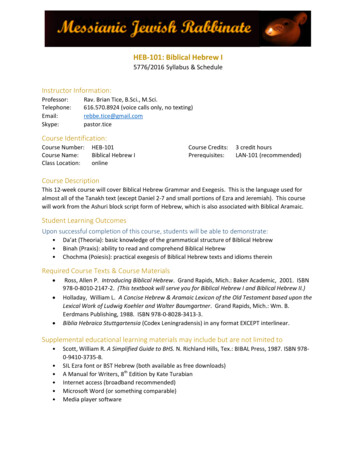

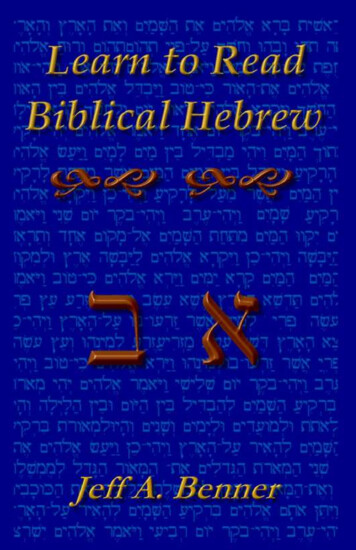
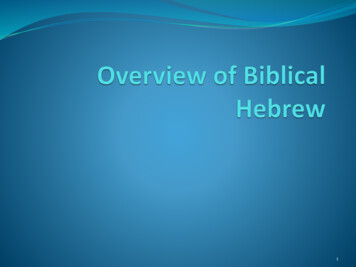
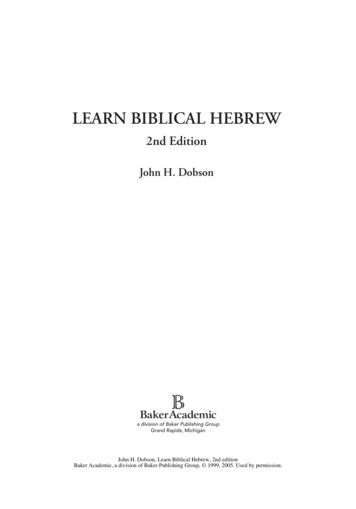
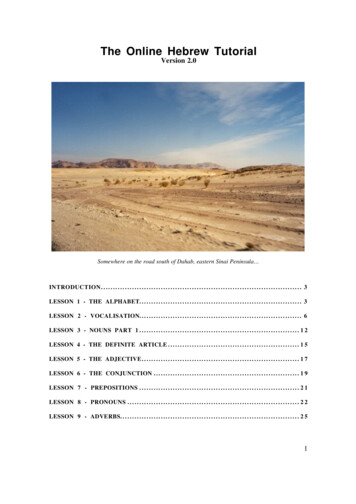

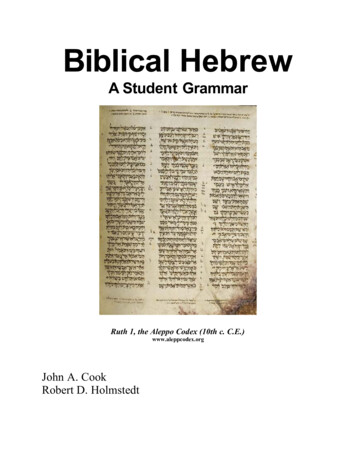
![A GRAMMAR FOR BIBLICAL HEBREW tyrIb][i - DrBarrick](/img/22/b-b-hebrew-grammar-wkbk-full.jpg)
